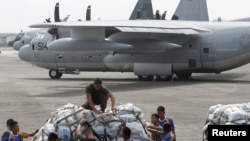UNITED NATIONS —
A senior U.N. humanitarian official said Monday that nearly 10 million people in the Philippines have been affected by the massive typhoon that ravaged the country on Friday.
John Ging, operations director of the U.N.’s humanitarian office, told reporters that 9.8 million people have been affected and 660,000 displaced from what he said was the biggest typhoon recorded in nearly a century.
Ging said the devastation wa huge and the U.N. was mobilizing for a massive response.
“We, in the United Nations and with our international NGO partners, are very much in support and we are focused on - as you would expect -- first and foremost, on the requirements for food, the requirements for shelter support, the requirements for medical support, to prevent the outbreak of public health disasters with so many people - estimated now over 10,000 people perished,” he said.
Ging expressed hope that the death toll would not go higher, but said everyone must be prepared for the worst as responders reach remote areas.
He commended the Philippine authorities, who he said were responding in a “very impressive” way.
Ging said efforts to reach those in need were complicated by logistical constraints, including damage to infrastructure, roads and airports.
U.N. Humanitarian chief Valerie Amos is on her way to the Philippines where she will launch an appeal for funds on Tuesday. In the meantime, the U.N. has released $25 million from its Central Emergency Relief Fund to assist aid agencies in quickly mobilizing relief efforts.
The international community has responded rapidly, sending plane loads of emergency supplies, medical and rescue teams.
John Ging, operations director of the U.N.’s humanitarian office, told reporters that 9.8 million people have been affected and 660,000 displaced from what he said was the biggest typhoon recorded in nearly a century.
Ging said the devastation wa huge and the U.N. was mobilizing for a massive response.
“We, in the United Nations and with our international NGO partners, are very much in support and we are focused on - as you would expect -- first and foremost, on the requirements for food, the requirements for shelter support, the requirements for medical support, to prevent the outbreak of public health disasters with so many people - estimated now over 10,000 people perished,” he said.
Ging expressed hope that the death toll would not go higher, but said everyone must be prepared for the worst as responders reach remote areas.
He commended the Philippine authorities, who he said were responding in a “very impressive” way.
Ging said efforts to reach those in need were complicated by logistical constraints, including damage to infrastructure, roads and airports.
U.N. Humanitarian chief Valerie Amos is on her way to the Philippines where she will launch an appeal for funds on Tuesday. In the meantime, the U.N. has released $25 million from its Central Emergency Relief Fund to assist aid agencies in quickly mobilizing relief efforts.
The international community has responded rapidly, sending plane loads of emergency supplies, medical and rescue teams.








